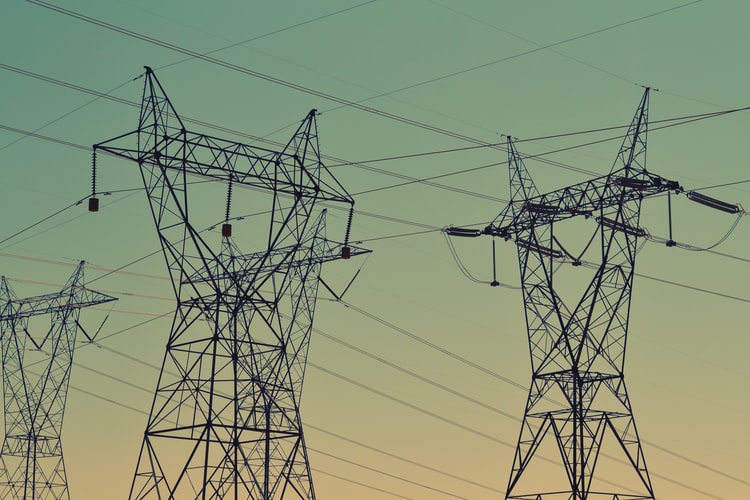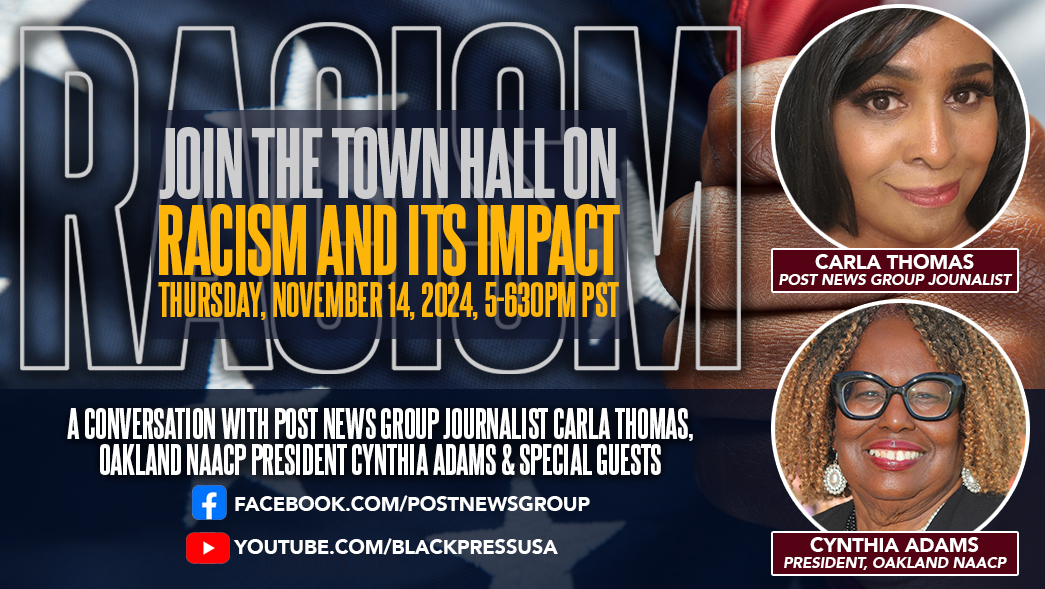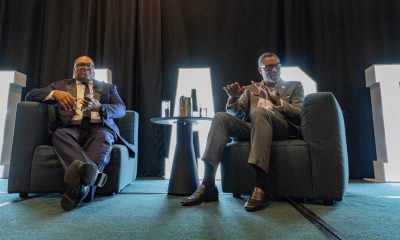Community
PG&E Announces Major New Electric Infrastructure Safety Initiative to Protect Communities from Wildfire Threat
PG&E’s commitment represents the largest effort in the U.S. to underground power lines as a wildfire risk reduction measure.

Pacific Gas and Electric Company on July 21 announced a major new initiative to expand the undergrounding of electric distribution power lines in High Fire Threat Districts (HFTD) to further harden its system and help prevent wildfires.
The new infrastructure safety initiative, announced in Butte County by PG&E Corporation CEO Patti Poppe, is a multi-year effort to underground approximately 10,000 miles of power lines.
PG&E’s commitment represents the largest effort in the U.S. to underground power lines as a wildfire risk reduction measure.
“We want what all of our customers want: a safe and resilient energy system,” Poppe said. “We have taken a stand that catastrophic wildfires shall stop. We will partner with the best and the brightest to bring that stand to life. We will demand excellence of ourselves. We will gladly partner with policymakers and state and local leaders to map a path we can all believe in.”
In addition to significantly reducing wildfire risk, undergrounding also benefits customers by lessening the need for Public Safety Power Shutoffs, which are called as a last resort during dry, windy conditions to reduce the risk of vegetation contacting live power lines and sparking a wildfire. Undergrounding also eases the need for vegetation management efforts, leaving more of California’s trees untouched.
Today, PG&E maintains more than 25,000 miles of overhead distribution power lines in the highest fire-threat areas (Tier 2, Tier 3 and Zone 1)—which is more than 30% of its total distribution overhead system.
About 10,000 miles of PG&E lines represents approximately the distance of 11 round trips from Chico to Los Angeles or almost half way around the world. The exact number of projects or miles undergrounded each year through PG&E’s new expanded undergrounding program will evolve as PG&E performs further project scoping and inspections, estimating and engineering review.
Public Engagement with Stakeholders to Guide New Undergrounding Plan
PG&E will engage customers and stakeholders as it develops a plan and reviews potential additional undergrounding sites based on a variety of factors, including local municipal planning and safety considerations.
Engineering an underground electric system requires designing the system around existing water, natural gas and drainage systems, as well as planning for future road widening. PG&E intends to work closely with customers and local, state, federal, tribal and regulatory officials throughout this new safety initiative.
Learning from Projects to Inform Expanded Undergrounding Effort
In the past, undergrounding has been done on a select, case-by-case basis, and largely for reasons other than wildfire risk reduction. Thanks to breakthroughs PG&E has achieved on undergrounding projects in recent years, undergrounding can now play a much more prominent role in PG&E’s ongoing efforts to harden the electric grid.
Following the devastating October 2017 Northern California wildfires and the 2018 Camp Fire, PG&E began to evaluate placing overhead power lines underground as a wildfire safety measure, and to better understand the construction and cost requirements associated with undergrounding for system hardening purposes. These demonstration projects were part of PG&E’s Community Wildfire Safety Program (CWSP) and included the following:
- From 2018-2020, PG&E completed multiple demonstration projects aimed at converting overhead power lines to underground in high fire-threat areas of Alameda, Contra Costa, Nevada, and Sonoma counties.
- As a part of the rebuild efforts following the October 2017 Northern California wildfires, PG&E completed undergrounding eight miles of power lines in the Larkfield Estates and Mark West Estates communities in Sonoma County in 2018.
- In 2019, PG&E announced it would rebuild all its power lines underground in the town of Paradise as it helps the community recover from the Camp Fire. The company is also rebuilding power lines underground within the 2020 North Complex Fire footprint in Butte County.
Through these demonstration projects and rebuild efforts, PG&E has been able to refine the construction and cost requirements associated with targeted undergrounding, enabling the acceleration and expansion of undergrounding projects. Learnings include:
- Implementing new planning systems and strategies and using new materials and new equipment to make undergrounding more cost effective.
- Building strong partnerships with material suppliers and contractors to accelerate undergrounding efforts.
- Partnering with natural gas projects as well as phone and internet providers to joint trench and share costs, where possible.
- Using new technology and construction methods to increase trench production.
- Bundling work into larger blocks to take advantage of economies of scale.
- Testing new cable and conduit materials to accelerate undergrounding work processes.
Ongoing PG&E Wildfire Mitigation and Resiliency Efforts
In addition to significantly expanding its undergrounding, PG&E’s ongoing safety work to enhance grid resilience and address the growing threat of severe weather and wildfires continues on a risk-based and data-driven basis, as outlined in PG&E’s 2021 Wildfire Mitigation Plan (WMP).
This includes:
- Installing stronger poles and covered power lines
- Deploying remote grids and community microgrids
- Targeted sectionalizing and grid reconfiguration
- Investing in centralized data analytics to reduce risk
- Conducting enhanced vegetation management
- Scaling the deployment of emerging technologies to proactively mitigate wildfire risk
Learn more about PG&E’s wildfire safety efforts by visiting pge.com/wildfiresafety.
To watch a recording of the July 21 announcement, visit PG&E’s YouTube channel.
Deanna Contreras is the North Bay and North Coast spokesperson
for PG&E’s North Bay, Sonoma and Humboldt Marketing and Communications Divisions
Activism
An Inside Look into How San Francisco Analyzes Homeless Encampments
Dozens of unhoused people are camped at Sixth and Jesse streets in San Francisco’s South of Market neighborhood. Tents made of tarps and blankets, piles of debris, and people lounging alongside the allies and walls of businesses are seen from all angles. These are some of the city’s hotspots. City crews have cleared encampments there over 30 times in the past year, but unhoused people always return.

By Magaly Muñoz
Dozens of unhoused people are camped at Sixth and Jesse streets in San Francisco’s South of Market neighborhood. Tents made of tarps and blankets, piles of debris, and people lounging alongside the allies and walls of businesses are seen from all angles.
These are some of the city’s hotspots. City crews have cleared encampments there over 30 times in the past year, but unhoused people always return.
But it’s normal to have tents set up again within less than 24 hours after an encampment sweep, David Nakanishi, Healthy Streets Operation Center Manager at the Department of Emergency Management, says. Sometimes there’s less people than before but often there is also no change.
“Most of the people that were in the encampments that want to go inside, we’ve gotten the majority of those [into shelter],” Nakanishi says. “Many of the people we encounter now, are those who have various reasons to not accept shelter, and some are already in shelter/housing”.
Since the ruling of Grants Pass by the US Supreme Court earlier this summer, which allows cities the authority to ban people from camping or sleeping on the streets, San Francisco has been at the head of the conversation to crack down on encampments.
Where neighboring cities in the Bay Area are clearing encampments a few days a week, San Francisco is sweeping 10 times a week, two per weekday.

David Nakanishi, Healthy Streets Operation Center Manager at the San Francisco Department of Emergency Management, makes a 311 report on an encampment in the Mission District. These reports allow smaller city teams to tackle individual spots where unhoused people frequent. Photo by Magaly Muñoz.
Considering the controversy that plagues the city around its harsh policies, the Post decided to tag along on a ride with Nakanishi to show us how he decides what encampments make it on the city’s sweep list.
Nakanishi, having over 20 years of experience in homelessness management, drives around the busiest parts of the city almost daily. He’s tasked with arranging a weekly sweeping operation schedule for city teams to engage with unhoused folks to help get them off the streets.
So what exactly is he looking out for when deciding what encampments get swept?
It depends, he says.
Locations like schools, recreational centers, senior centers, or businesses are places he tends to want to address quickly, especially schools. These are the places where the complaints are highest and access to facilities is important for residents.
He says he also takes into account 311 calls and reports made to him by city staff. On the date of publication, over 100 calls and reports were made about encampments around the city, according to San Francisco data.

Makeshift structures built from plywood and tarps are starting to pop up more throughout the city. Certain areas under freeways are not under direct authority from San Francisco, making it harder to sweep these encampments. Photo by Magaly Muñoz.
Nakanishi made a few 311 reports himself on the ride along, pulling over to take photos and describe the encampments into his 311 app. He says it helps him remember where to possibly sweep next or allows smaller teams in the city to engage quicker with individuals on the streets.
Nakanishi also looks at the state of the encampments. Are there a lot of bulky items, such as furniture, or makeshift structures built out of tarps and plywood, blocking areas of traffic? Is trash beginning to pile up and spill into the streets or sidewalks? Sites that meet this criteria tend to be contenders for encampment sweeps, Nakanishi says.
Street by street, he points out individuals he’s interacted with, describing their conditions, habits, and reasons for denying assistance from the city.
One man on 2nd St and Mission, who rolls around a blue recycling bin and often yells at passing pedestrians, has refused shelter several times, Nakanishi says.
People deny shelter for all kinds of reasons, he says. There’s too many rules to follow, people feel unsafe in congregate or shared shelters, or their behavioral and mental health problems make it hard to get them into proper services.

Inside a tent left by an unhoused man on Stevenson and 14th Street in San Francisco. The area smelled of human waste and leftover alcohol. Photo by Magaly Muñoz.
Nakanishi references another man on South Van Ness under the freeway, who city outreach have attempted to get into shelter, but his screaming outbursts make it difficult to place him without disturbing other people in the same space. Nakanishi says it might be an issue of the man needing resources like medication to alleviate his distress that causes the screaming, but the city behavioral team is in the process of outreaching him to figure that out.
In October, city outreach teams engaged with 495 unhoused people. 377 of those engaged refused shelter and only 118 accepted placements, according to city data. That number of monthly referrals is consistent throughout the entirety of 2024 so far.
Nakanishi has long advocated for the well-being of unhoused people, he explains. In 2004, he was working with the Department of Public Health and told then-Mayor Gavin Newsom that there needed to be more housing for families. Nakinishi was told it was easier to deal with individuals first and the city “will get there eventually.” 20 years later, family housing is still not as extensive as it could be, and the waiting list to get placements for families is a mile long with over 500 names.
In 2020, he was a Senior Behavioral Health Clinician at a hotel in the city during the pandemic. He says in 2021 he collaborated with DPH to provide vaccines to those staying in the makeshift hotel shelters once those became available.

Nakanishi strips apart a solo tent on Stevenson and 14th Street in San Francisco. He discards items, like tarps and cardboard, so that people cannot reuse them to make another sleeping structure. Photo by Magaly Muñoz.
Despite the constant media attention that city outreach is inhumanely treating homeless people, so much so that it has led to lawsuits against San Francisco from advocates, Nakanishi says not a lot of people are seeing the true conditions of some encampments.
He describes soiled clothing and tents, drenched in urine, and oftentimes rodents or bug infestations in places where people are sleeping. He’s asked homeless advocates- often those who are the most critical about the city’s work- who have shown up to observe the sweeps if those are conditions the city should allow people to be subjected to, but not many have answers for him, Nakanishi says.
The city’s “bag and tag” policy allows city workers to throw away items that are “soiled by infectious materials” such as bodily fluids and waste.
Sweep operations are conducted at 8am and 1pm Monday through Friday. People at the encampments are given 72 hour notice to vacate, but some don’t leave the area until the day of the sweep.
City outreach workers come out the day before and day of to offer resources and shelter to those interested. The Department of Public Works discards any trash that is left over from the sweep and washes down the area.
Nakanishi told the Post that the only time the city takes tents or personal possessions from residents is when folks become physically violent towards workers and police take the items as evidence. Other items taken are bagged and tagged in accordance with city policy.
Stories from local newspapers such as the San Francisco Standard and the Chronicle show instances of SFPD handcuffing residents while their items are thrown in the trash or disposing of personal possessions without reason.
Advocates have long been pushing for a more competent and compassionate process if the city is going to choose to continue sweeping unhouse people.
No matter the lawsuits and constant criticisms from allies, the encampment sweeps are not slowing down, even with the cold weather quickly approaching the coastal city.
Nakanishi says there aren’t a lot of large encampments left in San Francisco so now they do runs of streets in order to stretch out the sweeps as much as possible.
It’s calculated strategies and years of first hand knowledge that make this job work, “It takes dedication to the work, caring for the people and the community, and persistence, patience and sometimes good luck to make the positive changes for the people on the street,” Nakanishi says.
Activism
Oakland Post: Week of November 13 – 19, 2024
The printed Weekly Edition of the Oakland Post: Week of November 13 – 19, 2024

To enlarge your view of this issue, use the slider, magnifying glass icon or full page icon in the lower right corner of the browser window. ![]()
Activism
LIVE! — TOWN HALL ON RACISM AND ITS IMPACT — THURS. 11.14.24 5PM PST
Join us for a LIVE Virtual Town Hall on the Impact of Racism hosted by Post News Group Journalist Carla Thomas and featuring Oakland, CA NAACP President Cynthia Adams & other Special Guests.
Thursday, November 14, 2024, 5 p.m. – 6:30 p.m. PST

Join us for a LIVE Virtual Town Hall on the Impact of Racism hosted by Post News Group Journalist Carla Thomas and featuring Oakland, CA NAACP President Cynthia Adams & other Special Guests.
Thursday, November 14, 2024
5 p.m. – 6:30 p.m. PST
Discussion Topics:
• Since the pandemic, what battles have the NAACP fought nationally, and how have they impacted us locally?
• What trends are you seeing concerning Racism? Is it more covert or overt?
• What are the top 5 issues resulting from racism in our communities?
• How do racial and other types of discrimination impact local communities?
• What are the most effective ways our community can combat racism and hate?
Your questions and comments will be shared LIVE with the moderators and viewers during the broadcast.
STREAMED LIVE!
FACEBOOK: facebook.com/PostNewsGroup
YOUTUBE: youtube.com/blackpressusatv
X: twitter.com/blackpressusa
-

 Alameda County3 weeks ago
Alameda County3 weeks agoAlameda County District Attorney Pamela Price Announces $7.5 Million Settlement Agreement with Walmart
-

 Activism3 weeks ago
Activism3 weeks ago‘Jim Crow Was and Remains Real in Alameda County (and) It Is What We Are Challenging and Trying to Fix Every Day,’ Says D.A. Pamela Price
-

 Bay Area3 weeks ago
Bay Area3 weeks agoIn the City Attorney Race, Ryan Richardson Is Better for Oakland
-

 Activism3 weeks ago
Activism3 weeks agoOakland Post: Week of October 30 – November 5, 2024
-

 Alameda County2 weeks ago
Alameda County2 weeks agoD.A. Price Charges Coliseum Flea Market Vendors in Organized Retail Theft Case
-

 Activism3 weeks ago
Activism3 weeks ago‘Criminal Justice Reform Is the Signature Civil Rights Issue of Our Time,’ says D.A. Pamela Price
-

 Activism3 weeks ago
Activism3 weeks ago“Two things can be true at once.” An Afro-Latina Voter Weighs in on Identity and Politics
-

 Arts and Culture3 weeks ago
Arts and Culture3 weeks agoMacArthur Fellow Jericho Brown’s Poetry Reflects Contemporary Culture and Identity




















































